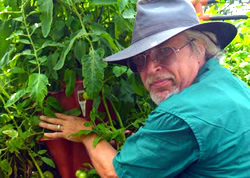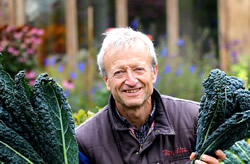
Gardening

Former Army tech Larry Johnson has spent his career improving computer and telephone systems so when he saw inefficiencies in how we grow our food, he decided to create a new system for farming your yard. His EZGro garden uses aquaponics, stacked towers, and custom pots to create a high-density vertical garden (HDVG) on as little land as a deck, rooftop, or parking space.

Historically, farms and forests have been at odds. Conventional wisdom says we have to cut down the forest to make way for agriculture.But a growing movement called agro-forestry “capitalizes” on the free services forests provide farmers and gardeners.Not only do trees protect more delicate edible plants from the elements and extreme weather, they provide nutrients, water, pest control and pollination services.Although you might not find all your traditional annual veggies in a forest garden, you will discover hundreds of new varieties of edible plants you never knew existed, that are often more nutrient-dense and flavorful

"Winter temperatures in Alliance, Nebraska can drop to -20°F (the record low is -40°F/C), but retired mailman Russ Finch grows oranges in his backyard greenhouse without paying for heat. Instead, he draws on the earth's stable temperature (around 52 degrees in his region) to grow warm weather produce- citrus, figs, pomegranates - in the snow. Finch first discovered geothermal heating in 1979 when he and his wife built it into their 4400-square-foot dream home to cut energy costs. Eighteen years later they decided to add a 16'x80' greenhouse in the backyard. The greenhouse resembles a pit greenhouse (walipini) in that the floor is dug down 4 feet below the surface and the roof is slanted to catch the southern sun. To avoid using heaters for the cold Nebraska winter nights, Finch relies on the warm underground air fed into the greenhouse via plastic tubing under the yard and one fan". I would love to do this!

I am now gardening with Charles Dowding method and I really like it. Charles says: "My 'maximum compost' method for starting out. Add a lot to make new beds, then very little in subsequent years. The cardboard is only for this stage of smothering weeds - keep them in the dark and they expire! Then you don't need to lay any more cardboard, once there are no weeds". He has a page for a beginner that I just discovered. It is filled with good advice. His videos are all over Youtube and are inspirational. Here is the link to the page.

Nearly 40% of Russia’s Food Still Comes From Small, Family Gardens
This is a good model as there is going to be an engineered food crisis coming to America. (Listen to the Ice Age Farmer on Youtube this is his area of expertise). If you shop for groceries you know that there are shortages and the prices are going up while the jars, cans, and other packaging is shrinking.
While most of the world is completely dependent on industrial agriculture, the Russian people feed themselves.
As recently as 2011, a full 40% of the food produced in Russia came from small, household gardens called dachas. "In 2011, 51% of Russia's food was grown either by dacha communities (40%), like those pictured left in Sisto-Palkino, or peasant farmers (11%) leaving the rest (49%) of production to the large agricultural enterprises. But when you dig down into the earthy data from the Russian Statistics Service you discover some impressive details. Again in 2011, dacha gardens produced over 80% of the countries fruit and berries, over 66% of the vegetables, almost 80% of the potatoes and nearly 50% of the nations milk, much of it consumed raw".